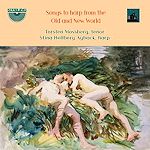

|
||||||||||||
Orlandus LASSUS (1532–1594)
Passio Domini nostri Jesu Christi secundum Mattheum (St Matthew Passion, 1575)
Musica Ficta [Torsten Nielsen (baritone, Evangelist); Lauritz Jakob Thomsen (baritone, Jesus); Ann-Christin Wesser Ingels (soprano); Louise Odgaard (soprano); Eva Wöllinger-Bengtsson (alto); Josef Hamber (tenor); Tobias Aabye Dam (tenor); Rasmus Kure Thomsen (bass-baritone)]/Bo Holten
rec. 6, 9 & 10 April 2015, Isaiah Church, Copenhagen, Denmark. DDD.
Text and translation included.
Reviewed as lossless press preview.
NAXOS 8.573840 [88:18] First released in 2017 in Scandinavia only as 8.573826.
Lagrime di San Pietro (Tears of St Peter, 1594)
Gallicantus/Gabriel Crouch
rec. St Michael’s Church, Highgate, London, 2-4 January 2013. DDD.
Texts and translations included.
Reviewed as 24/96 download with pdf booklet from hyperion-records.co.uk.
SIGNUM SIGCD339 [53:21]Let me first express my gratitude to Bo Holten and his team for giving us what it says in the title. An earlier (1994) recording with the same title contains much less Lassus, within the framework of plainchant (Harmonia Mundi HMU907076: Theatre of Voices/Paul Hillier, with the Easter Visitation of the Sepulchre and the Exsultet from the Easter Vigil). In any event, Lassus’ music is too little known to worry about any duplication. Perhaps the neglect stems from the fact that he is known by so many names – he seems originally to have been Orlande Latre, but alias Orlande de Lasse and Orlando di Lasso.
What Holten has attempted is not so much a reconstruction of what Lassus’ music might have sounded like when sung in Munich in 1575 but rather what he thinks ‘might be a way of making Lassus’ wonderful music accessible to a modern audience, making its natural and reticent telling of the story easy and appealing to follow’.
Be aware that despite Holten’s presentation, Lassus’ St Matthew Passion is very different from Bach’s masterpiece. It’s closer to the near-plainsong style of the early renaissance settings such as Richard Davy’s St Matthew Passion, contained in the Eton Choirbook1. What Holten has done, however, is to set Lassus’ beautiful polyphonic choral music within the plainchant setting. Sample, if you can, track 16, the inserted Good Friday motet Animam meam dilectam tradidi (I have betrayed my beloved soul into the hands of the wicked). He even includes an excerpt from Lassus’ Italian madrigal collection Lagrime di San Pietro (Tears of Saint Peter) at the appropriate point midway through the narrative.
That may well set you in search of the complete Lagrime, also very well performed by Bo Holten, with Ars Nova, on an earlier Naxos release (8.553311). Now that Naxos prices have risen to the upper end of the budget-price bracket, another very fine recording from Philippe Herreweghe and the Ensemble Vocal Européen is also recommendable (Harmonia Mundi d’Abord HMA1951483, target price £6.75 – review – DL News 2014/11).
A third very fine recording, from Gallicantus and Gabriel Crouch comes at full price (Signum SIGCD339 – review) but can be downloaded from Hyperion, with pdf booklet, for £5.99 (16-bit) or £9.00 (24-bit). Any one of these would do very nicely but the availability of the Signum in very good 24/96 sound from Hyperion, at a reasonable price – less than other download suppliers and less than the CD – may well clinch the matter. Lassus’ last known work, Lagrime makes a fitting supplement to the Matthew Passion.
I must also include a reminder another recording which features Lassus’ music for Passiontide. If you missed my strong recommendation of Stile Antico’s Passion and Resurrection (Harmonia Mundi HMU807555) in 2013 or John Quinn’s review of the same – Recording of the Month – now is the time to catch up. Lassus’ setting of the responsory In Monte Oliveti is only one of the treasures there.
Nor should you miss an enterprising Toccata release of Lassus’ responsories for the sacred Triduum, Maundy Thursday to Holy Saturday (TOCC0404 – review – review).
It’s not clear why Lassus’ passion settings are so sparse, but this recording insets into the rather austere chant polyphonic jewels of great beauty, all rounded off with a performance of Agnus Dei. Austere settings of Passiontide music can be very moving, as in the case of Schütz’s St Matthew Passion, almost a century later (1666)2, but I found the pairing of austerity and beauty on the new Naxos Lassus recording extremely effective.
It’s less clear why Holten has decided to divide the music after the excerpt from Lagrime di San Pietro between the events of Maundy Thursday and those of Good Friday. There is no liturgical reason to do so: the St Matthew Passion would have been recited on Palm Sunday and the St John on Good Friday. There was no Passion reading at Mass on Maundy Thursday, the gospel for that day referring to the blessing of the oils.
That’s a minor niggle when the performances and recording are so good. Having listened in very decent mp3 via Naxos Music Library, I was pleased that the CD-quality press preview sounded even better. The full text and translation are included but that seems to have reduced the space for Bo Holten’s notes to just one side; I would have liked more.
The supposedly inviolable 80-minute limit for CDs was breached some time ago, but I don’t remember one so long as this. It’s certainly not a question of ‘never mind the quality; feel the width’, but it’s good to have this austere but beautiful setting, enlivened with polyphony, in very fine performances and all contained on a CD running to over 88 minutes. Complement it with the Lagrime di San Pietro.
1 There used to be an Argo recording of this, the earliest known setting by a named composer (ZRG558). It would be wonderful to have that restored to the catalogue. Failing that, there’s a performance on YouTube in a reconstruction of the whole work, with Tyndale’s English translation. The Tonus Peregrinus recording on Naxos, welcome as it is, represents only the second half of the setting (8.572840 – review – review – Bargain of the Month).
2 Usually explained as the effect of the 30-years war having reduced the number of singers available to him. For Paul Hillier’s DaCapo recording, please see DL Roundup April 2011/2. Apologies for extending that war by a further ten years and calling it the 40-years war in that roundup!
Brian Wilson
Previous reviews (Signum): Johan van Veen ~ Jake Barlow (Recording of the Month)
 |
 |
 |
 |









